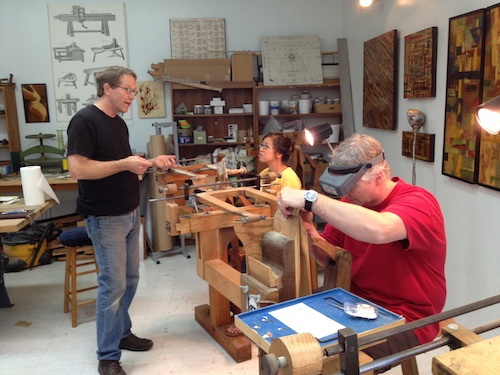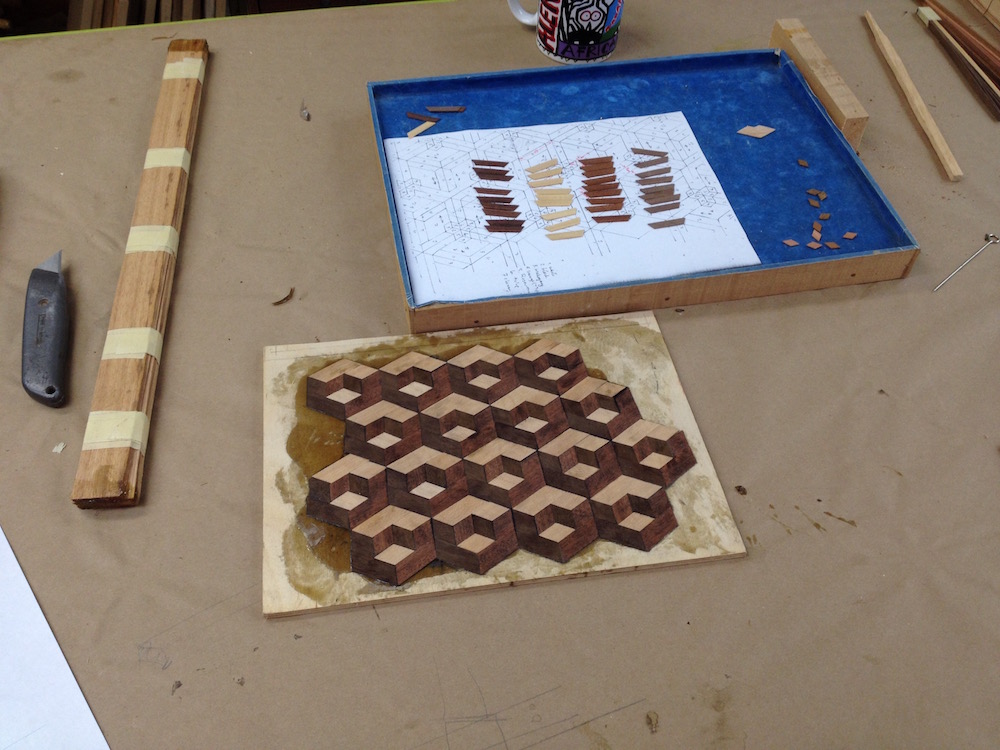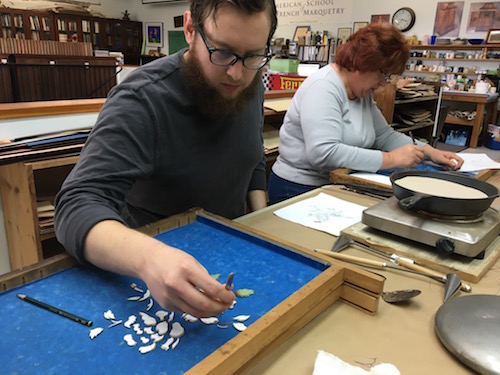2018 / 2019 Schedule of Classes
FULL WEEK CLASSES (5 DAYS)*
|
2018 September 24 - 28 |
2019 February 4 - 8 |
2019 May (Full) |
2019 September 23 - 27 |
*Full week classes are held Monday through Friday, 9am to 5pm
2018 / 2019 Schedule of Classes
FULL WEEK CLASSES (5 DAYS)*
|
2018 September 24 - 28 |
2019 February 4 - 8 |
2019 May (Full) |
2019 September 23 - 27 |
*Full week classes are held Monday through Friday, 9am to 5pm
All classes, Stage I Boulle, Stage II Classic Method (Piece by Piece), Fusion, Geometrica, and Independent Study, are taught concurrently.These classes use the "chevalet de marqueterie" to cut the pieces, the same process as used at ecole Boulle in Paris. Class size is limited to 7 students. Teachers are Patrick Edwards and Kristen Arrivee and Patrice Lejeune.
The cost for each stage is $750. A deposit of $350 is required for each stage, and must be sent in with an application to reserve a place in the American School of French Marquetry. The balance of $400 is due before or on the first day of class. Full payment can be made in advance. We accept checks and all major credit cards. On cancellations made six weeks before the class begins, payments will be returned. Any payments received are fully refunded if cancellation is made six weeks before class begins. Late cancellations will be reschuduled, space available, for another course.
No previous experience in woodworking or marquetery/veneer is required.
Class text book is "Marquetry" by Pierre Ramond.
A student handbook is provided.
This class is designed to introduce the student to the chevalet, and no previous experience in marquetry is required. Class 100 is required for all of the other classes at ASFM which use the chevalet as a cutting tool.
The Boulle method consists of cutting all materials in a single packet simultaneously, by interchanging the elements, positive and negative designs will be assembled. Students will complete three different projects, and learn how to make a traditional assembly board with Kraft paper. Basic instruction on using hot protein glue is also included. All tools and materials are provided.

Note : Prerequisite
This class introduces the student to the most advanced method of marquetry, developed by the french marquetry craftsman during the 18th century. Cutting the elements of the design separately from the background veneers allows for a minimum of waste and a maximum of production. The great advantage of this technique is the ability to cut from 8 to 12 copies at the same time, each identical to the other. In addition, the student will be tought how to use hot sand to create the traditional shading creating a dramatic effect to the composition. All tools and materials are provided.

Note: Completion of Class 100 recommended
Painting in Wood is a variation of the Boulle method, and was used as a process throughout Europe, where the chevalet was not available.This technique permits to realize very intricate pieces like the Piece by Piece technique and benefits greatly form the use of the chevalet. Accuracy in cutting is not critical, this class is often taken as a second week class for those students who complete Class 100 but do not wish to advance directly to Class 200. Hot sand shading to create dramaitic effects will also be taugth. All tools and materials are provided.

 Geometrica (Parquetry)/ Traditional Veneering and Hide Glue
Geometrica (Parquetry)/ Traditional Veneering and Hide GlueThis class does not use the chevalet. Historic methods of using veneers to create geometric patterns, such as “frisage” and “jeux de fond” will be taught, as well as the essential method of hammer veneering.
Extensive use of both hot animal protein glue and liquid protein glues will provide students with practical experience.
A variety of clamping method will be demonstrated, such as hot sand bags, hot/cold veneer press and vacuum systems. All tools and materials are provided.
 Independent Studies
Independent StudiesNote: Prerequisite Class 100 and 200 or 201
This class is designed to allow more advanced students the opportunity to work in the school on their own projects or on more advanced projects provided by the school.
Appropriate instruction and consulting will be provided and customized by instructors, and as for all classes, all of the tools in the school are available.
Depending on the material they may have to be purchased but at cost.
The schedule and the project is to be determined between the student and the school.
ASFM instructor and school founder. Currently holds teaching degrees in the fields of Antiques, Physics, Mathematics, History, Philosophy, Art History and Appreciation, Decorative Arts and Related Technologies. Graduated UCSD with BA in Applied Physics and Information Science, minor American History. Graduate studies at Winterthur Museum, University of Delaware, and ecole Boulle, Paris, with focus on French Marquetry and French Polish.
ASFM instructor. Graduated form the Ecole Boulle with a major in Furniture making and design and “minor” in Marquetry and finishing. Art history student at the University La Sorbonne in Paris. Furniture and marquetry restorer, designer and maker at Antique Refinishers, Inc. Contemporary marquetry artist.
School President, Administrator at ASFM and Antique Refinishers Inc.. Bachelor of Arts, Long Beach State University, Charter Oak State College. Creative process coach & art instructor, jewelry designer and avid gardner.